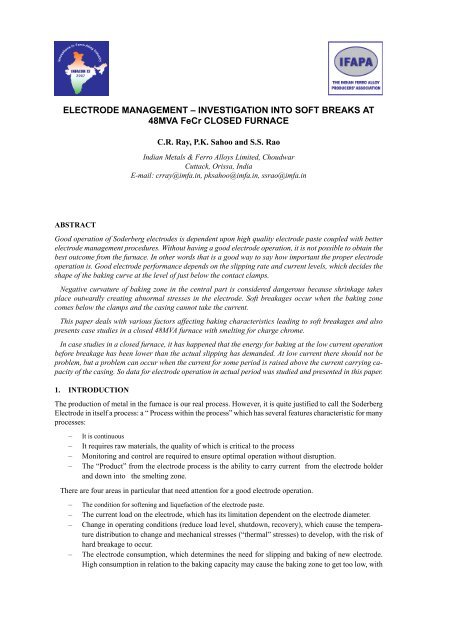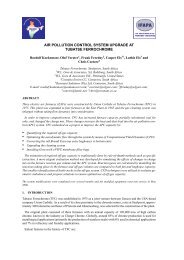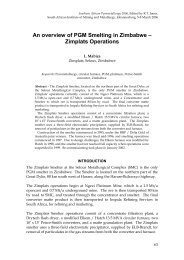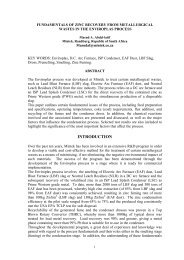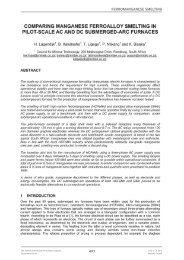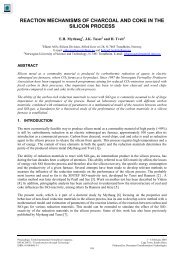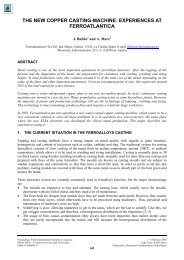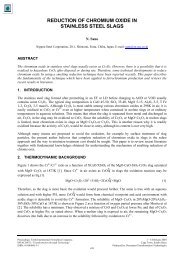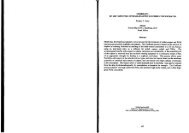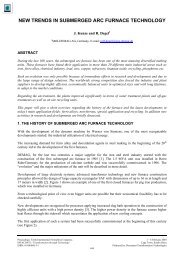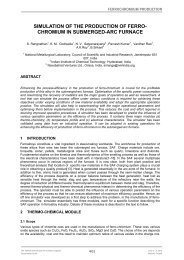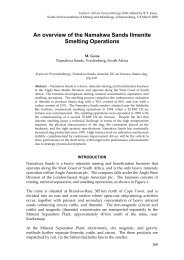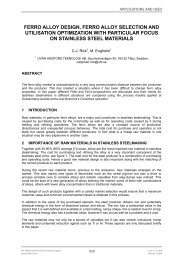ELECTRODE MANAGEMENT – INVESTIGATION INTO ... - Pyro.co.za
ELECTRODE MANAGEMENT – INVESTIGATION INTO ... - Pyro.co.za
ELECTRODE MANAGEMENT – INVESTIGATION INTO ... - Pyro.co.za
Create successful ePaper yourself
Turn your PDF publications into a flip-book with our unique Google optimized e-Paper software.
<strong>ELECTRODE</strong> <strong>MANAGEMENT</strong> – <strong>INVESTIGATION</strong> <strong>INTO</strong> SOFT BREAKS AT<br />
48MVA FeCr CLOSED FURNACE<br />
C.R. Ray, P.K. Sahoo and S.S. Rao<br />
Indian Metals & Ferro Alloys Limited, Choudwar<br />
Cuttack, Orissa, India<br />
E-mail: crray@imfa.in, pksahoo@imfa.in, ssrao@imfa.in<br />
ABSTRACT<br />
Good operation of Soderberg electrodes is dependent upon high quality electrode paste <strong>co</strong>upled with better<br />
electrode management procedures. Without having a good electrode operation, it is not possible to obtain the<br />
best out<strong>co</strong>me from the furnace. In other words that is a good way to say how important the proper electrode<br />
operation is. Good electrode performance depends on the slipping rate and current levels, which decides the<br />
shape of the baking curve at the level of just below the <strong>co</strong>ntact clamps.<br />
Negative curvature of baking zone in the central part is <strong>co</strong>nsidered dangerous because shrinkage takes<br />
place outwardly creating abnormal stresses in the electrode. Soft breakages occur when the baking zone<br />
<strong>co</strong>mes below the clamps and the casing cannot take the current.<br />
This paper deals with various factors affecting baking characteristics leading to soft breakages and also<br />
presents case studies in a closed 48MVA furnace with smelting for charge chrome.<br />
In case studies in a closed furnace, it has happened that the energy for baking at the low current operation<br />
before breakage has been lower than the actual slipping has demanded. At low current there should not be<br />
problem, but a problem can occur when the current for some period is raised above the current carrying capacity<br />
of the casing. So data for electrode operation in actual period was studied and presented in this paper.<br />
1. INTRODUCTION<br />
The production of metal in the furnace is our real process. However, it is quite justified to call the Soderberg<br />
Electrode in itself a process: a “ Process within the process” which has several features characteristic for many<br />
processes:<br />
– It is <strong>co</strong>ntinuous<br />
– It requires raw materials, the quality of which is critical to the process<br />
– Monitoring and <strong>co</strong>ntrol are required to ensure optimal operation without disruption.<br />
– The “Product” from the electrode process is the ability to carry current from the electrode holder<br />
and down into the smelting zone.<br />
There are four areas in particular that need attention for a good electrode operation.<br />
– The <strong>co</strong>ndition for softening and liquefaction of the electrode paste.<br />
– The current load on the electrode, which has its limitation dependent on the electrode diameter.<br />
– Change in operating <strong>co</strong>nditions (reduce load level, shutdown, re<strong>co</strong>very), which cause the temperature<br />
distribution to change and mechanical stresses (“thermal” stresses) to develop, with the risk of<br />
hard breakage to occur.<br />
– The electrode <strong>co</strong>nsumption, which determines the need for slipping and baking of new electrode.<br />
High <strong>co</strong>nsumption in relation to the baking capacity may cause the baking zone to get too low, with
742 INFACON XI<br />
the risk of breakage in the un-baked part of the electrode as a <strong>co</strong>nsequence: “Soft breakage”.<br />
In general, soft breakage or paste leakage can happen because of the following reasons.<br />
i) Mechanical failure in casing (fig.1)<br />
– Design (thickness, steel quality, “window” size / distance<br />
– Welding<br />
ii) Burning of casing too early (fig.1)<br />
– Too fast slipping<br />
– Too slow baking<br />
Figure 1<br />
iii) If too high current in steel casing (fig.2)<br />
iv) Position of 500 deg. C isotherm (fig-3):<br />
Figure 2<br />
– 500deg. C isotherm can be predicted and <strong>co</strong>ntrolled
Electrode Management – Investigation into Soft Breaks At 48MVA FeCr Closed Furnace 743<br />
-<br />
Figure 3: Position of 500deg.C isotherm<br />
In this paper, it is dealt with the case studies of soft breakages including the discussion about the baking and<br />
slipping details of electrodes during that time.<br />
DATA OF <strong>ELECTRODE</strong> AT IMFA, CHOUDWAR:<br />
Electrode Diameter : 1.55m<br />
Electrode Current, Normal<br />
: 90 kA<br />
Electrode Current, Max.<br />
: 93 kA<br />
Slipping rate, Normal<br />
: 0.5m/day<br />
<strong>ELECTRODE</strong> CASING:<br />
<strong>ELECTRODE</strong> SLIPPING RATE:<br />
Type of casing : Cylindrical Max. slipping, mm/A2*h : 2.65E-09<br />
Welding to the electrode <strong>co</strong>lumn, method : Welding of fins Safe slipping at max. el. current, m/day : 0.44<br />
Thickness of sheet in casing, mm : 3.15 Max. slipping at max. el. current, m/day : 0.55<br />
Thickness of sheet in fins, mm : 3.15 Current density at normal current, A/cm2 : 4.8<br />
Number of fins : 14 Current density at max., A/cm2 : 4.9<br />
Width of fin, mm : 310<br />
Fin foot, mm : 40<br />
Width of windows, mm : 50<br />
Height of windows, mm : 130<br />
Steel area outer casing & fin foot, mm2 : 16260<br />
Net steel area fins, mm2 : 10920<br />
Total net steel area casing, mm2 : 27180<br />
Current carrying capacity of casing, kA : 68<br />
Two cases have been chosen for study of soft breaks and the details are given case wise.<br />
2. CASE – 1<br />
2.1 Description of electrode <strong>co</strong>ndition at the time of soft break (date of breakage 11 th Sep’02)<br />
On 11 th Sep’02, at 12:30hrs. black fumes marked over the top of the casing. During inspection after furnace<br />
was switched off, it was observed that liquid paste was leaking just below <strong>co</strong>ntact clamp tip from electrode<br />
no.2 and spread over all around the furnace top. Paste level was measured and found minus side 0.6mtr (i.e.<br />
below top of the <strong>co</strong>ntact clamp). Furnace was partially dug out to clear the molten paste which was spread all
744 INFACON XI<br />
over. A new casing in <strong>co</strong>nical shape was welded from the bottom for rebuilding of the electrode before restart<br />
of the furnace. It took total 06 days furnace shutdown to make ready for switching on.<br />
Relevant data for electrode operation in actual period and one day before of breakage is submitted along<br />
with Electrode model.<br />
2.2 Critical data for electrode operation<br />
Table 1<br />
Date Time E1 E2 E3 Time E1 Time E2 Time E3 slipping<br />
slipping slipping<br />
In hrs. kA kA kA In hrs. In mm In in mm In hrs in mm<br />
hrs.<br />
10 th Sep'02 06.00am 94 95 94 6.15 20<br />
7.00 94 95 95 7.15 20 7.30 20 7.00 20<br />
8.00 94 96 96 8.30 20 8.45 20<br />
9.00 96 96 96 9.45 20 9.00 20<br />
10.00 96 95 96 10.00 20<br />
11.00 94 94 96 11.00 20 11.15 20 11.00 20<br />
12.00 94 92 96 12.15 20 12.30 20 12.30 20<br />
13.00 94 92 94 13.30 20 13.45 20<br />
14.00 94 92 90 14.45 20 14.00 20<br />
15.00 92 95 91 15.00 20 15.15 20<br />
16.00 88 93 94 16.00 20 16.15 20 16.30 20<br />
17.00 95 92 96 17.15 20 17.30 20 17.45 20<br />
18.00 93 92 94 18.30 20 18.45 20<br />
19.00 90 95 88 19.45 20 19.00 20<br />
20.00 95 95 93 20 20.00 20 20.15 20<br />
21.00 94 94 94 21.00 20 21.15 20 21.30 20<br />
22.00 95 96 93 22.15 20 22.30 20 22.45 20<br />
23.00 95 93 93 23.30 20 23.45 20<br />
24.00 87 95 90 24.45 20 24.00 20<br />
1.00 95 96 79 2.10 20 1.00 20 1.15 20<br />
2.00 84 96 96 2.30 20 2.15 20 2.30 20<br />
3.00 90 92 96 3.15 20 3.30 20 3.45 20<br />
4.00 92 79 78 4.30 20 4.45 20<br />
5.00 94 84 78 5.45 20 5.00 20<br />
6.00 90 84 80 6.00 20<br />
11 th Sep'02 06.00am 90 84 80 6.15 20<br />
7.00 88 80 70 7.00 20 7.15 20 7.30 20<br />
8.00 92 93 93 8.15 20 8.30 50 8.45 50<br />
9.00 88 88 80 9.30 20 9.45 20<br />
10.00 92 88 92 10.45 20 10.00 20<br />
11.00 96 80 86 11.00 20 11.15 50<br />
12.00 96 84 88 12.00 40 12.15 20 12.30 20<br />
Black fumes observed at E2 casing at 12.57hrs.
Electrode Management – Investigation into Soft Breaks At 48MVA FeCr Closed Furnace 745<br />
2.3 Electrode Current and slip hours before breakage (fig-4)<br />
Figure 4<br />
2.4 Calculated slip index “last 8 hours” (fig –5)<br />
Figure 5
746 INFACON XI<br />
2.5 Temperatures calculated with Elkem electrode model for electrode -2 (fig – 6)<br />
Figure 6<br />
(The temperature of the electrode model is calculated on day average current basis)<br />
2.6 Electrode 2 Vs. Electrode 3 (fig – 7)<br />
Figure 7<br />
(The temperature of the electrode model is calculated on day average current basis)<br />
2.7 Conclusion (CASE-1)<br />
It is clearly evident from the above analysis that the soft breakage has happened due to:<br />
– Slipping faster than baking rate<br />
– 500deg.C isotherm has moved towards tip of the holder<br />
– Current in casing and fins higher than tolerated<br />
– .Steel casing / fin melted<br />
– Paste flown out and baked part fallen down<br />
– Except the above, remaining all electrode management parameters like casing design, paste management<br />
found maintained as per requirement.
Electrode Management – Investigation into Soft Breaks At 48MVA FeCr Closed Furnace 747<br />
3. CASE – 2<br />
3.1 Description of electrode <strong>co</strong>ndition at the time of soft break (date of breakage 26th Apr’05)<br />
In this case also, liquid paste was observed leaking through the casing holes below the <strong>co</strong>ntact clamp tip<br />
where casing was punctured. Paste level was measured and found minus 0.2mtr i.e. below the <strong>co</strong>ntact clamp<br />
top position. This time, it took 04 days to clear total leaked paste all around the electrode to switch on the<br />
furnace with all necessary arrangements.<br />
3.2 Data presented before the breakage relating to currents, slipping and paste temperature<br />
Table 4<br />
Date Time in Hrs Electrode current (kA) Slipping in mm In hrs.<br />
(Slipping/time in hrs)<br />
E1 E2 E3 E1 E2 E3<br />
24/04/2005 6:00 64 74 62 20 20<br />
7:00 60 60 60 20<br />
8:00 73 72 65 20<br />
9:00 72 73 67 20<br />
10:00 70 65 65 20 20<br />
11:00 75 77 76 20<br />
12:00 77 72 68 20<br />
13:00 80 80 65 20<br />
14:00 66 71 67 20 20<br />
15:00 80 79 70 20<br />
16:00 75 61 67 20<br />
17:00 72 67 65 20 20<br />
18:00 64 64 59 20<br />
19:00 75 81 63 20<br />
20:00 81 60 52 20 20<br />
21:00 83 73 78 20<br />
22:00 73 83 73 20<br />
23:00 78 82 75 20 20<br />
0:00 80 80 78 20<br />
1:00 76 76 65 20<br />
2:00 70 69 56 20 20<br />
3:00 80 71 66 20<br />
4:00 73 79 43 20<br />
5:00 65 73 50 20 20<br />
6:00 61 66 40 20<br />
25/04/2005 6:00 61 66 40 20<br />
7:00<br />
8:00 46 48 12 20<br />
9:00 60 70 30 20 20<br />
10:00 64 72 24<br />
11:00 62 70 22 20 20<br />
12:00 60 46 24 20<br />
13:00 52 62 32 20<br />
14:00 64 68 36 20<br />
15:00 66 70 50 20 20<br />
16:00 (15:30)
748 INFACON XI<br />
Table 4 (Continued)<br />
Date Time in Hrs Electrode current (kA) Slipping in mm In hrs.<br />
(Slipping/time in hrs)<br />
E1 E2 E3 E1 E2 E3<br />
17:00 72 65 58 20 20<br />
18:00 65 75 74 20<br />
19:00 70 77 83 (18:30) 20 20<br />
20:00 78 78 78<br />
21:00 76 65 63 20 20 20<br />
22:00 77 65 67 (21:30)<br />
23:00 56 60 75 20 20<br />
0:00 74 67 65 20 20<br />
1:00 65 77 85 (00:30) 20 (00:45)<br />
2:00 72 67 68 20<br />
3:00 75 70 68 20 20 (02:30)<br />
4:00 69 73 70 (03:30) 20<br />
5:00 72 64 68 20 (04:30)<br />
6:00 73 66 64<br />
26/04/2005 6:00 73 66 64 20 20<br />
7:00 72 60 62 (06:30) 20 (06:30)<br />
8:00 76 70 78 20<br />
9:00 60 68 72 20 20 (08:30)<br />
10:00 56 58 62 (09:30) 20<br />
11:00 72 68 80 20 (10:15)<br />
12:00 80 82 77 20 20<br />
13:00 65 60 62 (12:30) 20<br />
14:00 78 58 68 20<br />
15:00 66 50 64 20<br />
16:00 74 65 66<br />
17:00 62 54 66<br />
18:00 66 72 60<br />
19:00 70 68 60<br />
20:00 72 66 68<br />
21:00 70 72 68<br />
22:00 62 62 64<br />
23:00 71 61 77<br />
0:00 84 70 65<br />
1:00 68 69 83<br />
2:00 64 64 75<br />
3:00 69 58 84<br />
4:00 Shutdown for E-3 green breakage at 03:40 hrs<br />
5:00 - - - - - -<br />
6:00 - - - - - -<br />
(E1-Electrode 1, E2-Electrode 2, E3-Electrode 3)
Electrode Management – Investigation into Soft Breaks At 48MVA FeCr Closed Furnace 749<br />
Apr'05<br />
23-04-<br />
05<br />
24-04-<br />
05<br />
25-04-<br />
05<br />
26-04-<br />
05<br />
El.<br />
No<br />
E<br />
-1<br />
Paste Level (Mtr.) Charging Temperature<br />
(Deg. C)<br />
Before<br />
Filling<br />
After<br />
Filling<br />
Cylinder<br />
No.<br />
Broken<br />
Paste (Kg)<br />
Cyl Height In<br />
Mtr.<br />
Fins Cyl. Top Mw Ka<br />
Load Current. Remarks<br />
2.8 3.1 - 750 3.3 55 47 37.5 78 Normal<br />
E-2 3.0 3.1 - 250 5.2 55 46 37.5 75 Normal<br />
E-3 3.0 3.1 - 250 - 56 50 37.5 63 Normal<br />
E<br />
-1<br />
3.0 3.1 - 250 - 55 - 37.5 78 Normal<br />
E-2 2.8 3.1 - 750 4.6 57 48 37.5 81 Normal<br />
E-3 2.7 3.0 6 750 8.4 60 32 37.5 68 Normal<br />
E<br />
-1<br />
3.0 3.1 - 250 - 57 - 28 70 Normal<br />
E-2 2.9 3.1 - 500 4.2 57 50 28 74 Normal<br />
E-3 3.1 3.2 3 250 8.4 60 35 28 30 Slightly<br />
liquid<br />
E<br />
-1<br />
2.9 3.1 5 500 7.7 58 32 37.5 72 Normal<br />
E-2 2.9 3.1 2 500 5.5 57 50 37.5 78 Normal<br />
E-3 3.3 3.3 - - 6.6 57 36 37.5 70 Normal<br />
3.3 Presentation of above data (in fig – 9 & 10)<br />
Figure 9
750 INFACON XI<br />
3.4 Discussion of the reasons<br />
The data indicates that baking zone had been in a marginal position for long time before the breakage and<br />
when followed with high current peaks for short time before breakage there was burning and some holes formation<br />
in casing caused the leakage.<br />
During the 09hours following the short shutdown 25 th Apr'05 at 07.00hrs the current on electrode 3 was very low and has<br />
<strong>co</strong>ntributed to a lowering of the baking zone.<br />
The slipping was not high but it was expected that the baking zone has moved downwards in this period.<br />
But problem can arise if the current in a period with low baking zone gets higher than the CCC (Current Carrying<br />
Capacity) and that happened also at 19.00 hrs. In the following period (26/4) the current had been close<br />
to the CCC with a baking capacity of max. 12mm/hr (max. slipping if every time else is perfect and stable)<br />
or 10mm/hr (safe slipping with same tolerances in the other parameters). The average slipping in the period<br />
was 11mm/hr and has then been between “safe” and “max”. The baking zone had been in a marginal position.<br />
The current peaks just before breakage, jumping from 65 to 83-84 kA has caused some burning in the casing<br />
and then caused the leakage.<br />
During the period of this breakage also, except above deviation remaining electrode management parameters<br />
like casing design, paste level etc. were found implemented as per requirement which was clear from the<br />
data submitted.<br />
4. CONCLUSIONS<br />
By maintaining proper slip index and current <strong>co</strong>ntrol to maintain the required baking zone positioning, soft<br />
breakages can be eliminated as they are very much <strong>co</strong>stly.<br />
Casing jointing and paste charging methods to be implemented as per the laid down procedures mentioned<br />
below to ensure better electrode management assuring no electrode breakages of any nature.<br />
Re<strong>co</strong>mmended Electrode management procedures:<br />
Figure 10<br />
– Paste cylinders should be stored such that they are protected from the sun.<br />
– Cleaning of the paste after storing (sand, dust etc.) should be done thoroughly.<br />
– Stable number of cylinders should be added.
Electrode Management – Investigation into Soft Breaks At 48MVA FeCr Closed Furnace 751<br />
– If it is only paste briquettes, it is wise to stop charging briquettes for some time until softening of<br />
the briquettes can be observed for a <strong>co</strong>ntrol of the soft paste level.<br />
– Electrode heaters and mantle <strong>co</strong>oling fan damper adjustment plays a vital role to maintain paste<br />
temperature.<br />
– When briquettes are used, the top of the dry briquettes will normally be 3 – 5 mtr. above top of<br />
holder.<br />
– The slipping rate should not be changed too often (<strong>co</strong>ntrol slip index if current changes).<br />
– Casing design should be appropriate to achieve less loss of power during electrode elongation and<br />
better tensile strength to have higher margin against soft breakage.<br />
– Paste temperature at the top of side paste level should be 65 – 70deg. C<br />
At IMFA, CHOUDWAR to elongate the electrodes, forced slipping method is being followed (from jan’03<br />
onwards) in which current is lowered to a level where the steel casing can carry all the current and the electrode<br />
is slipped 75mm/hr until needed length. After a re<strong>co</strong>very with that slipping, the elongated electrode can<br />
be slipped as normal.<br />
It is always better to avoid operational <strong>co</strong>ndition that resulting unfavorable segregation of the paste and it<br />
may be preferred to charge paste briquettes / crushed paste in <strong>co</strong>mbination with cylinder for better performance.<br />
At IMFA, CHOUDWAR, all the above procedures are being followed for better electrode management.<br />
REFERENCES<br />
[1] “Introduction to Soderberg Electrode”, By Elkem.<br />
[2] “Report on soft breakages at IMFA, CHOUDWAR”, By Reidar Innvaer & Bjonar Larsen (Elkem).<br />
[3] “Soderberg Electrode 75 th Anniversary Seminar, 1994.


